PORTUGAL
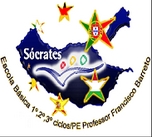
PARTICIPATING TEACHERS
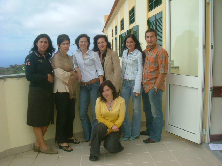
From left to the right: Isabel Magalhães, Judite Perestrelo, Sofia Aguiar, Nélia Sousa, Elisabete Perdigão, Johnny Santos e Adriana Guerreiro
PARTICIPATING CLASSES
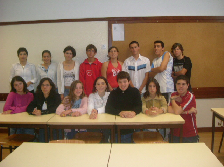
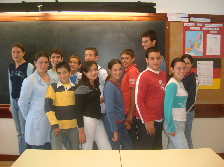
MADEIRA TRADICIONAL RECIPES
FRIED MAZE (Milho Frito)
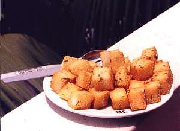
This will normally accompain the famous Espetada, meat on the stick.
1 kg corn maize
2 l water; 1 tablespoon lard
½ cabbage (finely chopped)
1 handful of broadbeans; salt to taste; spring of savoury
Add the salt, lard and savoury to the water. Add the cabbage and maize to the water while it is tepid. Mix constantly with a long wooden spoon till the mixture comes to a boil. Reduce heat and allow it to simmer, mixing occasionally. Pour the maize out into a plate.
BOLO DO CACO
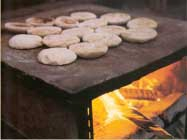
Ingredients:
750 g flour
1 coffee spoon bread leaven
50 g bread dough from the bakery
Salt
How to do it:
Bolt the flour into an earthenware bowl and join the leaven and the bread dough.
Add small portions of water with salt.
Mix and knead until you get an homogenous dough.
Divide it in small portions and make on each one a deep cut in cross with your hand.
Cover the table with a white table cloth and the table cloth with flour. On the top of it put the 4 portions of dough separate from each other.
Cover them with the table cloth and let them ferment until the cuts disappear.
Cook the dough over a clay or stone thin base put over tripods above high firewood.
SCABBARD FISH WITH PRAWNS (Espetada de Camarão)
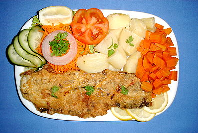
2 fillets scabbard fish
1 egg; flour
1 avocado pear
Prawns or shrimps
Mayonnaise
Cut the scabbard fillets into strips, the same length and thickness as a king prawn, season well. Dip the fish in beaten egg & coat with flower, carefully place in hot oil until golden brown. Cut the avocado in half & remove the stone, spoon out the flesh & mix with mayonnaise and prawns. When avocado, prawns & mayonnaise have been mixed, spoon back into the avocado skins. Place the filled avocado and the fried scabbard on a plate, garnish with parsley and serve with sweet pepper rice.
GRILLED LAPAS
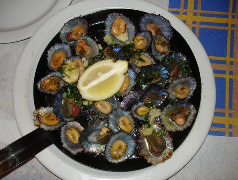
Madeira, as a rocky island has a special shellfish, easy to find and grab, it is called Lapas. This typical dish is usually grilled in a pan.
Ingredients:
Lapas
Butter
Garlic
Parsley
Pepper
Lemon
How to do it:
Put the washed lapas on a pan
Over them spread bits of butter, garlic, pepper and parsley if you like
Let them grill for about one hour
Serve them in the pan with quarters of lemon so each person may temper it according to their own taste
This dish is an appetizer and so it can be eaten only with home baked bread and red wine. Or, if you do it like a tasty morsel it will go wonderfully with a nice cold beer.
MADEIRA HONEY CAKE
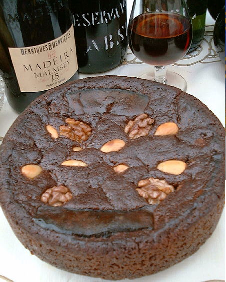
This is the recipe for the traditional Madeira Honey Cake, made usually on Christmas but also all round the year on the island of Madeira and named originally in Portuguese, bolo de mel.
Ingredients:
9 ounces (250 g) bread dough from the baker's shop
90 ounces (2.5 kg) flour
35 ounces (1 kg) sugar
26 ounces (750 g) banha, this is pork fat
17 ounces (500 g) butter
1 ounce (25 g) erva-doce, this is anise herbs, mashed and sifted
1.75 ounce (50 g) canela, which is cinnamon
1 ounce (25 g) cravinho da india, which are cloves in powder form
17 ounces (500 g) walnut, cut into halves
9 ounces (250 g) almonds, ground in the cutter
1.75 ounce (50 g) candied lemon peel, cut into cubes
60 ounces (1.8 l) pure honey
5 Tablespoons of baking soda, (dissolved in the Madeira Wine)
1 cup of madeira wine
juice and zest of 4 oranges
How to do it:
One day before making the cake buy the bread-dough at the baker's shop, pass a little bit of flour on the dough, put it in a towel and keep it in a warm place until next day.
Put the baking soda into the Madeira, dissolve. In a pan warm up the honey, join butter and pork fat (if not available, just use butter), dissolve. Let this mixture cool down.
Sift flour into a bowl, join sugar, shape a crater and put the bread dough in the middle. Now work the flour-sugar-mixture into the bread dough. As soon as this is well joined, start to incorporate little by little the (tepid) honey-fat-mixture. Join (part of) the candied lemon peel, the cup of Madeira Wine, orange juice and orange zest, anise, cinnamon, cloves.
Incorporate and knead thoroughly until the dough doesn't stick on the bowl. Cover the dough with a towel and put it into a warm cover. Keep it in a warm place for 3-4 days.
Divide the dough into parts of 250g or 500g or 750 g, depending on the pans to put into the oven. This cake is made in wide, round pans which are rather low. Before going into the oven, the cake is decorated with half-walnuts, sliced almonds and (the rest of) candied lemon peel.
Grease the baking pans, bake about 50 minutes 355 °F (180 °C). Let cool down before taking out of baking pan.
Notes, tips, and variations:
In Madeira these honey cakes are made on 8 December, which is traditionally considered the day of Mary's Immaculate Conception, because tradition says this cake is only good for Christmas if it is made on this day.
It is a custom to make enough of this cake in order to have some during the whole year. Once cooled down and thoroughly wrapped into vegetable paper it remains good until next Christmas without losing quality or taste.
Another tradition surrounding this cake is that it is not cut with knives but by hand and also eaten by hand, nothing more than a usual tradition but very respected among Madeira locals
PROJECT ACTIVITIES OF YEAR ONE
As a partner school in the Comenius project, students and teachers did all the activities possible to make this project come true. Therefore all teachers, pupils and parents were informed about the project.
Some teachers participated in a project meeting in Budapest, Hungary in November for the participating countries and those countries which will possibly participate next year. In March some teachers and students participated in another project meeting in Bremen, Germany. In these meetings some aims/ activities of the project were decided and organized.
The students were asked to fill in a Questionnaire related to their daily eating habits. One for weekdays and one for weekends.
We made a logo contest for the project which results were very good.
The students worked on the design of their “own” restaurant: They had to present a detailed drawing or model of the restaurant and created a menu. After that the group of students had to play a scene of some people in restaurant.
Practical work in the school canteen started with learning the basics of food technology.
The students formed research teams and each group worked on a typical meal from Madeira. After several lessons, internet-research as well as library visits, they were able to present a “Recipe Book For Typical Madeira Meals”.
